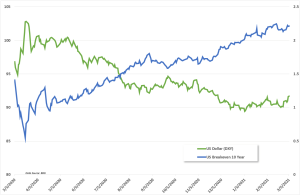The Relationship Between the US Dollar Index and Inflation
US Dollar Index and Inflation
One of the most popular ways to gauge currency strength is by looking at the US Dollar Index, or USDX. The index tracks the value of the United States dollar against a basket of other foreign currencies. Originally, the index included six currencies — the Japanese yen, British pound, Canadian dollar, Swedish krona, West German mark and Swiss franc — but since 1999, only the euro has been a part of the index.
Inflation is a price increase in goods and services, which can reduce the number of goods you can buy using a single unit of currency over time. This can have a significant impact on your wallet, as it can affect how much money you can spend on a monthly basis.

The ดัชนีดอลลาร์ สหรัฐ is a good indicator of inflation because it measures the value of the dollar relative to a basket of other currencies. The index is a valuable tool for investors, especially those looking to make currency trading decisions.
The Relationship Between the US Dollar Index and Inflation
When the dollar is strong, it makes imports cheaper for American consumers and it helps put downward pressure on inflation. This is because most of the goods and services that Americans buy abroad are invoiced in dollars, and a stronger dollar means less expensive imports.
Another reason the dollar is strengthening is because the Federal Reserve is ratcheting up interest rates in an effort to fight inflation, and it has been successful so far. The central bank is currently on a path to raise interest rates by an average of 3 percentage points over the next two years, and economists expect it to continue to hike the rate until it reaches 3% in 2023.
Inflation is a serious problem for the economy because it can create financial hardships and negatively affect the country’s GDP. It also can cause countries to default on their debts, which could lead to a recession.
There are many ways to measure inflation, including the Consumer Price Index (CPI) and producer price inflation (PPI). However, CPI is usually considered the most accurate way to assess how prices are trending in the U.S. Because of this, the CPI is the most common indicator used to track inflation.
The CPI is expected to print 7.9% year-on-year in February, up from 2.2% the month before, and investors are expecting the Fed to raise interest rates at its March meeting. This will push the DXY higher as well, and this will help to boost the economic outlook for the US.
Inflation has been a major driver for the United States in the past few months, and it is expected to continue its upward trajectory in the coming months as the economy continues to grow at a high pace. The Federal Reserve is expected to continue hiking interest rates, and this will also drive the dollar higher as investors look forward to higher inflation.